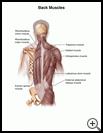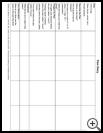
Backache
What is a backache?
A backache is pain and stiffness in the back. The middle or lower back is the most common area to have pain. Backaches are more common during adolescence.
With a backache:
- The pain is worsened by bending.
- The muscles on either side of the spine are tender or in spasm.
What causes backaches?
Backaches are usually caused by straining some of the 200 muscles in the back that allow us to stand upright. Often the strain is caused by carrying something too heavy (such as schoolbags), lifting from an awkward position, or overusing back muscles (for example, from digging).
How long will it last?
The pain and discomfort are usually gone in 1 to 2 weeks. However, it is common for a child to have backaches many times, depending on your child's activities and health.
How can I take care of my child?
- Pain-relief medicines
Give acetaminophen (Tylenol) or ibuprofen (Advil). Continue this medicine until 24 hours have passed without any pain. This is the most important part of the therapy because back pain causes muscle spasm and these medicines can greatly reduce both the spasm and the pain.
- Cold
During the first 2 days, massage the sore muscles with a cold pack or ice pack for 20 minutes 4 times per day. To avoid frostbite, do not leave the cold packs on too long.
- Heat
After 2 days, put a heating pad or hot water bottle on the most painful area for 20 minutes to relieve muscle spasm. Do this whenever the pain flares up.
- Sleeping position
The most comfortable sleeping position is usually on the side with the knees bent. The mattress should be firm if possible.
- Activity
Have your child avoid lifting, jumping, horseback riding, motorcycle riding, and exercise until he is completely well. Complete bed rest is not necessary.
How can backaches be prevented?
The best way to prevent future backaches is to keep the back muscles in good physical condition. This will require 5 minutes of back and abdominal exercises every day. (Your child should not do strengthening exercises until the back pain is gone.) Help your child become more physically active. Children should get at least 30 minutes of physical activity every day.
Also, teach your child how to lift heavy objects properly:
- To lift heavy objects, bend your knees and not your back.
- Never lift something while your back is twisted.
- Carry heavy objects close to your body and use both arms.
When should I call my child's healthcare provider?
Call IMMEDIATELY if:
- The pain becomes very severe and persists more than 2 hours after your child takes pain medicine.
- Your child can't walk.
- Your child has pain, tingling, or weakness in the legs.
- Your child has changes in bowel or bladder function.
- Your child starts acting very sick.
Call during office hours if:
- The pain is no better after 3 days of treatment.
- Your child still has pain after 2 weeks.
- You have other concerns or questions.
Last modified: 2013-06-03
Last reviewed: 2017-06-05


